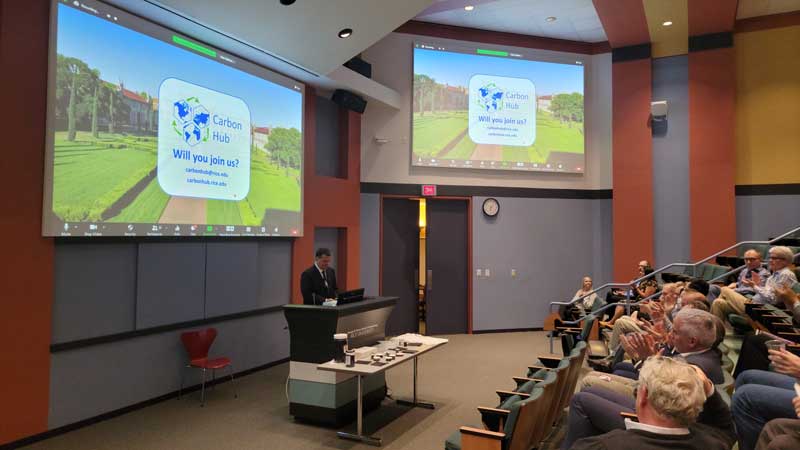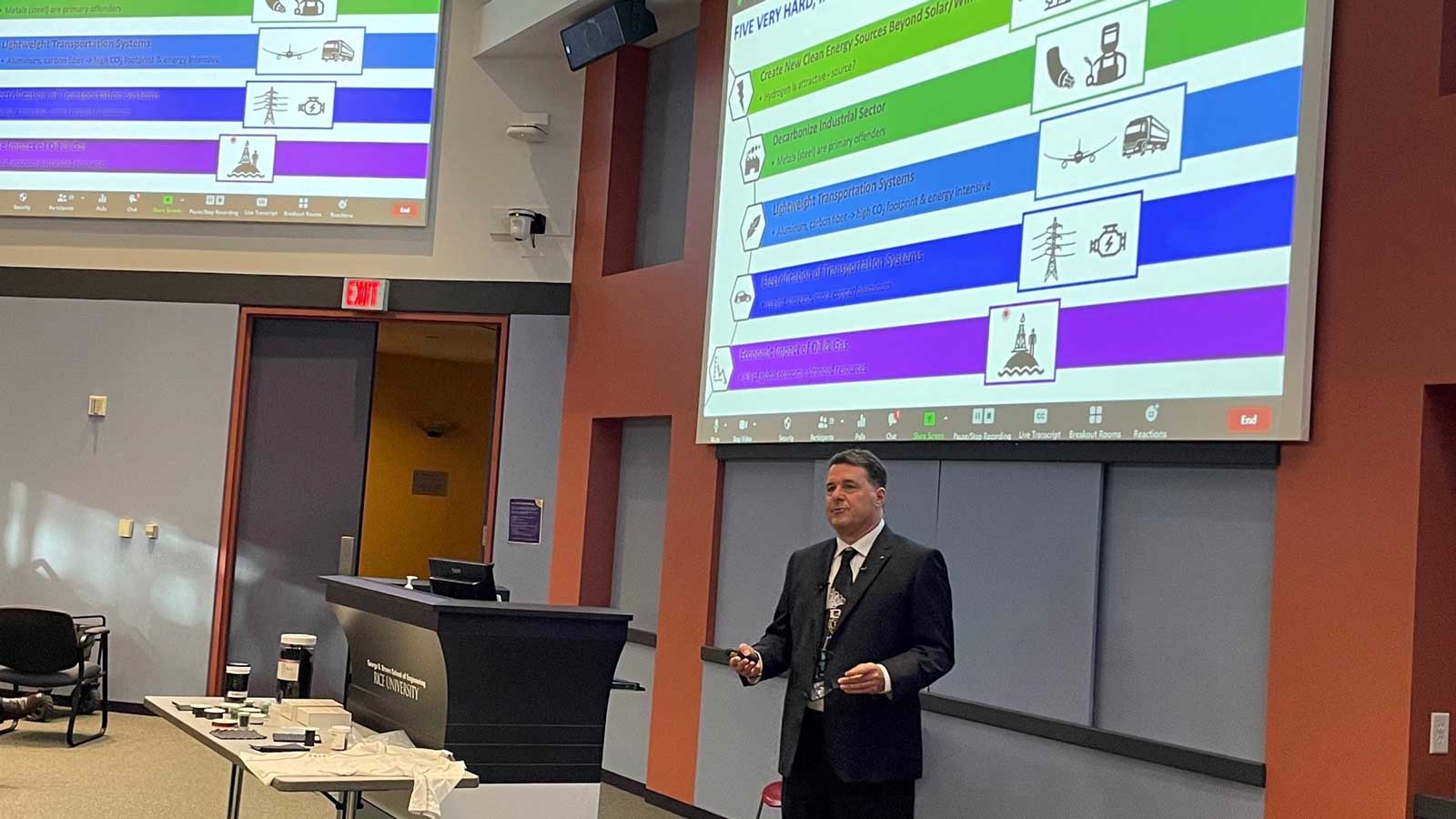The annual Chevron Lecture on Energy was given by Rice University’s own Matteo Pasquali on March 31, in McMurtry Auditorium. The lecture was also streamed online and recorded. There were a total of 110 attendees with about 70 attending in person and 40 on-line.
Pasquali is the A. J. Hartsook Professor of Chemical & Biomolecular Engineering, Chemistry, and Materials Science & NanoEngineering. He also directs the Carbon Hub. He joined the Rice University faculty in 2000 and has served in various capacities since, including Chair of the Department of Chemistry, Master of Lovett College, and Senator at Rice University. In addition, he has served as Chief Scientific Advisor at Shell, and as director of two startups he co-founded (DexMat and NanoLinea). Pasquali is an elected fellow of the American Association for the Advancement of Science (2018) and the American Physical Society (2016) and has won numerous awards including the National Science Foundation CAREER award, Goradia Innovation Grand Prize, Herschel Rich Invention Award, Schlack Prize for Man-Made fibers, and the Rice Presidential Mentoring Award. Pasquali has advised over 90 graduate students and postdocs, who are now in key positions in leading universities, industry, national laboratories, startups, and finance. Pasquali and his students have co-authored over 220 scientific articles and over 30 patents and patent applications, which have been cited over 17,000 times. His research has been funded by US government agencies, corporations, and private foundations. He holds a Ph.D. from the University of Minnesota and an M.S. from the University of Bologna, both in Chemical Engineering.
Pasquali’s research group (cf2 group) studies the interaction of flow and liquid micro- and nano-structure. Their work is applied to engineered materials that are formed and/or processed in the liquid state, such as polymers, which are complex fluids possessing intrinsic length scales that are well-separated from the macroscopic length scales of the process (e.g., reactor vessel) and the nanoscopic length scales of the solvent. In recent years, the cf2 group has applied these concepts to the understanding of Carbon NanoTube (CNT) materials to enable optimization of their synthesis and properties.

In his lecture, Pasquali described how CNT synthesis from hydrocarbons could be used to decarbonize or, rather, “de-COx-ify” (since it is carbon dioxide rather than carbon itself that leads to global warming) material manufacturing with the concomitant production of clean-burning hydrogen. Together with fossil fuel use for transportation, materials manufacturing (“making stuff”) is one of the leading sources of carbon dioxide emissions. Carbon dioxide capture and storage (CCS) is one means to reduce carbon dioxide emissions from these processes, but it is expensive and generates a huge waste stream that must be managed and stored.
Splitting hydrocarbons to generate pure carbon and hydrogen would eliminate this issue, but the global market for conventional carbon products (e.g., carbon black from methane pyrolysis) is very small. Carbon in the form of CNT, on the other hand, could potentially replace structural materials such as steel, aluminum, and carbon fibers, given the right properties. Research on synthesis and processing of CNT have led to materials with key properties (tensile strength and conductivity) that are comparable to these materials. However, the production cost is still high, so we need to “push like crazy” to get these costs down. As production of CNT scales up, costs will likely come down as seen in other areas, such as in the cost of solar panels and steel production, to name just two examples. Pasquali’s group is using science to reduce costs by improving the efficiency and scale of CNT synthesis, and some start-up companies are also making timely progress in this area.
In addition to cost reduction, design changes at the architectural level will be required for application of CNT as structural materials. Pasquali used the example of stone and its high compressive strength for building bridges versus steel, requiring a different design (e.g., suspension bridges) to take advantage of its high tensile strength. This is where the Carbon Hub comes in – creating a new field to push this technology out and get CNT adopted. The Carbon Hub was launched in late 2019 to provide for community building, education and workforce development, advocacy, and research for adoption of CNT technology. Unlike many research programs, the Carbon Hub embraces open collaboration, with funding of work not limited to Rice University. Pasquali highlighted work of other colleagues within the Carbon Hub, for example, efforts to create “synthetic biochar” that could amend agricultural soil, reducing the need for fertilizers and sustaining productive farming in areas that are marginally suited to agriculture.
During the Q&A at the end of the lecture, Pasquali was asked what policy issues there were that the Carbon Hub would need to address as part of its advocacy role. He explained that because this technology would neither reduce use of hydrocarbons, nor capture CO2 it would not be favored compared to other technologies such as CCUS, even though it would replace CO2-intensive materials and co-produce clean hydrogen. As it stands, this technology would have to stand on its economic benefits alone, without reference to its impact on CO2 emissions.
The annual Chevron lecture was established in 2013 to propagate various aspects of science and technology in energy. The Department of Chemical and Biomolecular Engineering at Rice hosts the lecture each year with the help of the Rice AIChE student chapter, the CHBE Graduate student association, the ChBE Alumni Committee, and department staff with generous sponsorship by Chevron.
By Charles Meyer, ChBE Alumni Committee

